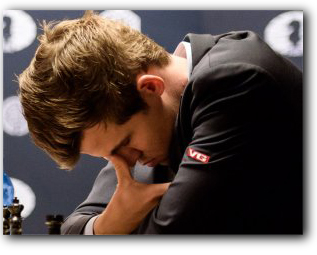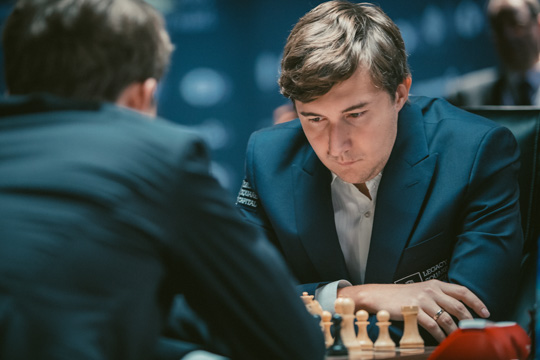


2016 has been a year of surprises, the Chicago Cubs winning a World Series in baseball, a once in a century occurrence; Brexit; Donald Trump… Oh my, what would be next? Certainly, the overwhelming pre-match consensus was clear: reigning Champion Magnus Carlsen would win. Ardent fans predicted a veritable stroll in the park for Magnus. Challenger Sergey Karjakin however had other ideas. Instead of playing to script he fought well in a wonderful, combative match equalizing the world champion in the 12 classical games with a 6-6 score. He might have done better.
The match started with two tame draws. The players can both be forgiven. Playing a WCM is a nerve-wracking affair. There is simply so much work to be done. Preparation for the game is just one aspect. There are the details of the hotel, seconds, supporters, meals and the like. Players are never so busy as during a WCM. It is easy to fall ill. Then there are the really challenging parts like dealing with the media. You know, those demanding journalists and photographers just asking you to smile. There are the duties of cooperating with the organizers, pre-match publicity television and radio show requests. It can seem endless. Most times you just want to close your hotel door and shut out the noise. It is vital that you get adjusted to a new sleeping schedule, get a Zen of the playing hall, become friends with your pieces, even the hated chess clock. To soak up the atmosphere of the event. To calm your nerves, to find your groove, to test your form, the first pair of games is an ideal time to do all of this. A pair of tame draws are not unusual.
Game 1 - Notes by Ruslan Ponomariov
Game 2 - Notes by Ruslan Ponomariov
The match really started in the next pair of games, 3 & 4. In these games Magnus really showed his best qualities. Why he is so formidable and why he was considered to be such a pre-match favorite. Game 3 was vintage Magnus. Nothing out of the Opening, he found some needling ways to pressure Sergey. Sensing things were turning against him, Sergey lashed out. With bad timing. Magnus was able to collect a pawn and hold some nagging pressures as well. From virtually nothing Magnus continued to nurse his advantage fully into a Knight. On the verge of winning in yet another outstanding performance something quite unexpected happened, Magnus did not win. First one very late slip, then another and Sergey found a study-like way to escape with a draw.
Game 3 - Notes by Yasser Seirawan
We were collectively stunned. Were we really in for a competitive match? Game 4 was in some ways Sergey’s worse and best game. Sugar plum fairies of beautiful wins danced in his head as he sacrificed a Bishop. Cool defense by Magnus snapped Sergey back to reality, he then panicked with a decision that he wouldn’t make. Ever. He traded his “Spanish Torture” light squared Bishop for a blocking Knight. I’m sure that after the game, Sergey couldn’t recognize or even understand how he could make such a strategic howler. Gifted with a dominating position, Magnus pushed hard. Two Bishops in an open position in the ending combined with a mobile pawn majority meant that the win was virtually in the vault.

Sergey Karjakin - Photos by Max Avdeev
Magnus has been quoted as saying, “I just don’t believe in fortresses.” You become the highest rated player in history no one is supposed to argue. Except when they must. On his forty-fifth move Magnus decided to advance his f-pawn, locking up the position and thereby offering his opponent hope of just such a fortress. Sergey tenaciously hung on for all he was worth and dodged bullet number two – draw! Whoa. Great defense had saved two huge half points. The match remained tied. Fans were getting restless. Magnus was getting frustrated. His lone solace was being on the sunny side of the board.
Game 4 - Notes by Dorian Rogozenco

Magnus Carlsen
While the battleground of the match, the Openings, was being settled, no great novelties or major surprises were in store, a possible pre-match strategy for Sergey was taking hold: Stay close. Draw as many games as possible. Clearly, Magnus was getting frustrated at his inability to score a victory.
With tensions rising a potential route to match victory was beginning to emerge: Frustrate Magnus, hold him, let him over reach. Game 5 was a dream come true for Sergey. Magnus switched his Opening for a third time in as many games with the White pieces. This time choosing the placid waters of the Giuoco Piano and for the third time received precisely nothing. A Bishop’s of opposite colors middle-game position was achieved but Magnus tried to press for an advantage that wasn’t there.
Sensing an opportunity, Sergey decided to strike out with a bold plan of his own, he would take a King walk to the Queenside and hope that if Magnus tried to (desperately) launch a Kingside pawn storm, where he held a majority, his King would be safe, out of harm’s way, while Magnus’ would be made vulnerable. The plan of such a boomerang worked to perfection. Magnus did precisely what Sergey hoped and opportunity for the first time knocked on his door. Unfortunately for Sergey he failed to fully answer. His pawn sacrifice on move forty-two was terrific, his follow up on move forty-three a mistake. Now it was Magnus’ turn to narrowly save the game. The match was well and truly in full swing, with both players now giving as good as they got.
Game No. 5 - Notes by John Nunn
While Magnus was getting nothing with the White pieces, Sergey wasn’t doing any better. Magnus kept threatening to play the Marshall Gambit in the Ruy. A threat Sergey took seriously and avoided. Game 6 featured a similar type of pawn sacrifice by Black. In this line of play, Black earns the two Bishops along with dynamic play. Magnus had no problems whatsoever and earned an easy draw.
Game No. 6 - Notes by Tiger Hillarp Persson:
The sixth in a row. At the halfway point the match was dead-locked. Both players had reasons to feel they had missed an opportunity. Magnus a bit more so. As the tensions built, chess fans asked themselves, would the fantastic training and preparations shown by the players mean that Capablanca’s fears of a hundred years earlier be proven right? That a properly played chess game between two elite masters would be destined for a draw?
To be continued - part three is going to follow soon.
| Advertising |